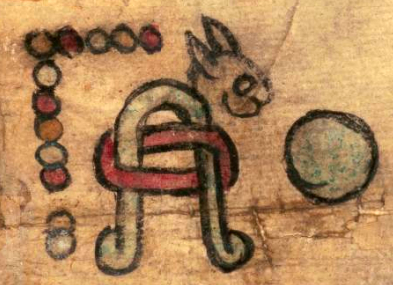Matlactli Omome Tochtli (CQ)
This combined simplex glyph and notation represents Matlactli Omome Tochtli, the year "twelve rabbit" (12-Tochtli, 12-Conejo, 12-Rabbit). The notation involves three groups of circles (ones). One group has five circles arranged in a horizontal row across the top of the box that contains the date. Another group of five connects with the first five, but it is arranged in a vertical row on the left side of the box. Finally, two more circles arranged in a short, vertical row are separated by a small gap from those circles in the group above it.
The coloring of the circles involves the repeating red, yellow, and white, but the reading order remains to be analyzed across this manuscript. The rabbit sign is just the animal's head (painted a gray-brown with a white nose), shown in profile, looking to the viewer's right. The head is attached to the Mixtec A-O sign, colored turquoise blue (xihuitl) and red, which means "year" (also xihuitl).
Stephanie Wood
The gap between the group of five ones and the group of two ones is a visual indicator of the ligature (om) in the resulting equation of ten (matlactli) plus (om) two (ome). While the visual notation separates the two fives (not with a visual ligature, but by having the second five shift into a vertical arrangement), the alphabetic and oral language combines the two fives into ten (matlactli).
The three colors of red, yellow, and white for the counters (ones) appear fairly regularly in this manuscript. The reading order required further study. Of course, these colors are echoed in the colors of maize and in cardinal directions.
The turquoise blue (xihuitl) color on the year (xihuitl) glyph employs homophony, as does the coloring of the larger circle in the contextual image. The colors employed in the smaller circles have yet to be analyzed fully.
As the contextualizing image shows, to the right of the solar year sign and notation is another (somewhat larger) circle by itself. It is also painted turquoise blue. This is an added explanation that what happened on this date endured for one year and another example of the use of homophony.
Stephanie Wood
covers ruling men and women of Tecamachalco through 1593
Stephanie Wood
The counting of the elements of this combination of glyph (rabbit) and notation (twelve) is a challenge. The glyph has one element. The number twelve could be counted as a second, but the small circles are grouped, which may be significant for reading the way Nahuas counted. And then there is the A-O (year) sign. Year-Twelve-Rabbit would be a total of three elements.
If the reading starts with "year" (the A-O sign), then the reading order goes upward (to the notation) and then downward and to the right (to the rabbit).
numbers, números, ones, unos, ten, diez, dos, two, doce, twelve, years, años, calendarios, calendars, rabbits, conejos, xiuhpohualli, turquesa, xihuitl, mahtlactli, nombres de años

matlactli omome, twelve, https://nahuatl.wired-humanities.org/content/matlactli-omome
toch(tli), rabbit, https://nahuatl.wired-humanities.org/content/tochtli
xihui(tl), year, https://nahuatl.wired-humanities.org/content/xihuitl
xihui(tl), blue-green, https://nahuatl.wired-humanities.org/content/xihuitl-0
Doce Conejo, 12-Conejo
Randall Rodríguez
The Codex Quetzalecatzin, aka Mapa de Ecatepec-Huitziltepec, Codex Ehecatepec-Huitziltepec, or Charles Ratton Codex. Library of Congress. https://www.loc.gov/item/2017590521/
The Library of Congress, current custodian of this pictorial Mexican manuscript, hosts a digital version online. It is not copyright protected.



